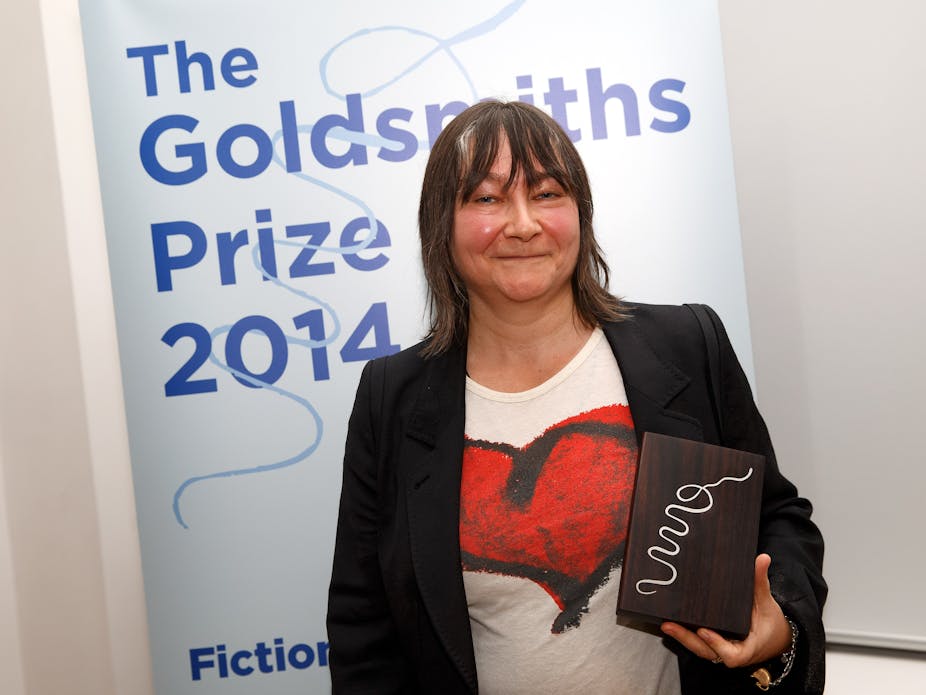Ali Smith has won the second ever Goldsmiths Prize for boldly original fiction for How To Be Both. There are two narrative sections to the book – and two versions of the actual novel. Which one you read simply depends on which version you pick up off the bookshop shelves. One part is narrated by 16-year-old George, who has recently lost her mother; the other by a 15th-century artist.
Two is apparently Smith’s magic number – she has now won two awards in the past two days: on November 11 she was awarded the Saltire Society Literary Book of the Year Award. Speaking of the importance of her Goldsmiths win, Smith praised the bravery of a prize which explicitly recognised the creative possibilities of the novel form. Tim Parnell, founder and literary director of The Goldsmiths Prize, explained:
There is a real need for a prize that rewards fiction at its most novel. Clearly, there is an appetite among readers for fiction which is restless with the constraints of convention and willing to draw on and exploit the near endless resources and possibilities of the novel form.
Readability or creativity?
Recently the major literary prizes, especially the Man Booker, have been criticised for seeming to eschew truly innovative fiction in favour of “readability.” John Berger’s G (1972) and James Kellman’s How Late It Was, How Late (1994), both Booker-winning novels, are often cited as examples of experimental writing that would not be rewarded by the prize as it is today. It is perhaps telling that Smith has been thrice shortlisted for the Booker, and twice for the Orange Prize – and yet never won.
In its first year the prize was won by Eimear McBride’s frankly staggering A Girl is a Half-Formed Thing. The novel took nine years to find a publisher before Galley Beggar Press took it up (it is now co-published with Faber), and went on to be nominated for a slew of awards – including this year’s inaugural Folio Prize – and win amongst others, the 2014 Bailey’s Prize (previously the Orange Prize) for female novelists.
Just these two authors between them flag up the range of literary prizes there are. Obvious questions are quick to follow: are there too many prizes and aren’t they all just doing the same thing?
That a novel celebrated for experimental and uncompromising narrative style can win both a prize for innovative fiction and also a much more mainstream award (and others besides) can be seen in two ways. Either it’s a comment on the growing acceptance and demand for original fiction, or a cause to question the value of literary prizes when the same books repeatedly monopolise accolades. And the prizes certainly have shortlisted many of the same books, as writer Nikesh Shukla criticised.
Publicity powerhouses
The inclusion of a novel on a short or longlist, even if it does not go on to win, cannot be underestimated. Jonathan Ruppin, web editor at Foyles Bookshop, who has sat on the judging panels for six literary awards (including two forthcoming in 2015), said:
As the number of books released in a year continues to swell and coverage of books in the mainstream media continues to shrink the coverage afforded to literary, awards is becoming an ever-more important sales factor. Indeed, for many novels, the chance of making a shortlist for a well-publicised award is often a significant part of stated promotional plans and publication is undertaken in the knowledge that without such an accolade, the book is likely to be a commercial failure.
There are a number of other new literary awards with a very clear focus. The Green Carnation (established in 2010) recognises the work of LGBT authors and the Gordon Burn Prize which, like the Goldsmiths Prize, awards “literature which challenges perceived notions of genre”. This niche positioning suggests an attempt to wrest attention from the simplistic notion of “the best novel” to something more innovative and audacious, often from literary communities that have previously been unrecognised by such awards.
Although Smith is already a very well-known author – and is with one of the most famous publishing houses – she made a point, in her acceptance speech, of commending Penguin for its courage in supporting her formally innovative novel. Alongside established publishers taking risks with well-known authors are pioneering indie presses such as Galley Beggar, Melville House, Reality Street, CB editions, and Unbound, all of whom continue to recognise and support experimental writing.
Parnell said that a publishers had mentioned to him that the prize: “had encouraged them to take on more innovative and daring fiction. There could be no better endorsement of the prize’s raison d’être than this”. Whilst the Booker prize changed its submissions policy to favour publishers of previous Booker winners, the Goldsmiths Prize’s brief seems to complement the work of these small presses.
So, are there too many literary prizes? Yes, probably. But – and there’s a big but here – ultimately the large number of literary prizes, in Britain and elsewhere, do succeed in clawing back a focus on the novel and the book trade. Since these prizes demonstrate the ability to influence the number of people reading about, talking about, and finally buying and reading books, there is no way they can ever be a bad thing. They might even change the way we think about fiction.

